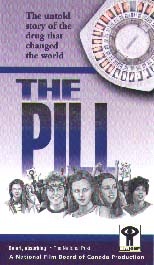|
________________
CM . . . .
Volume VII Number 2 . . . . September 22, 2000
excerpt: I think it captures, in a macrocosm of space and in a microcosm of time, it captures everything that's good and bad about science, about medicine, and about research, about how countries use each other, about the manufacturing process, about how money talks, and about how people make decisions related to the most intimate things in their lives on the basis of a lot of other people who are out there, in some cases constraining the decisions that they make.The Pill tells the story of the development of the birth control pill since it was first suggested as the "magic bullet" in the early 1900s. Research began in the early 1950s when Dr. Gregory Pincus began to develop and test the pill on laboratory rats. In the late 1950s, women in Puerto Rico were used as experimental subjects in clinical trials. The pill first became available in the early 1960s, and, by 1968, between 12 and 16 million women were using the pill. It was seen as the key to sexual freedom. But this sexual freedom was not to come without costs. The side effects were many. Women reported weight gain, headaches, cramping, nausea, high blood pressure, and blood clots. By 1968, Searle, the Drug Company that made the pill, had more than 100 cases of premature death that were linked to the pill. Many of these deaths had to do with blood clots that caused embolisms. As a result, "The Pill on the Hill" senate hearings were organized to look into the side effects and deaths. Gloria Steinem speaks on the video of the importance of these hearings, and the demonstrations that resulted from them, for the Women's Movement in the United States. The Pill is a very engaging video with television and film footage from the early 1950s mixed with recent testimonies from important writers, historians, female activists, and Puerto Rican women involved in the original trials. Other topics of interest mentioned in the video that may provoke class discussion include the women's movement, feminism, informed consent, medical research, the male pill, new methods of contraception, and the power of drug companies. Highly Recommended.
To comment on this title or this review, send mail to cm@umanitoba.ca.
Copyright © the Manitoba Library Association.
Reproduction for personal use is permitted only if this copyright notice
is maintained. Any other reproduction is prohibited without
permission.
Published by
TABLE OF CONTENTS FOR THIS ISSUE - September 22, 2000.
AUTHORS |
TITLES |
MEDIA REVIEWS |
PROFILES |
BACK ISSUES |
SEARCH |
ORDER |
CMARCHIVE |
HOME
|
